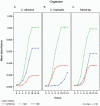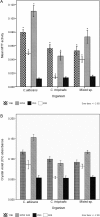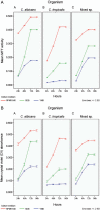Culture media profoundly affect Candida albicans and Candida tropicalis growth, adhesion and biofilm development
- PMID: 27706381
- PMCID: PMC5125054
- DOI: 10.1590/0074-02760160294
Culture media profoundly affect Candida albicans and Candida tropicalis growth, adhesion and biofilm development
Erratum in
-
ERRATUM.Mem Inst Oswaldo Cruz. 2020 Oct 19;115:e200294. doi: 10.1590/0074-02760200294ER. Mem Inst Oswaldo Cruz. 2020. PMID: 33084742 Free PMC article.
Abstract
As there are sparse data on the impact of growth media on the phenomenon of biofilm development for Candida we evaluated the efficacy of three culture media on growth, adhesion and biofilm formation of two pathogenic yeasts, Candida albicans and Candida tropicalis. The planktonic phase yeast growth, either as monocultures or mixed cultures, in sabouraud dextrose broth (SDB), yeast nitrogen base (YNB), and RPMI 1640 was compared, and adhesion as well as biofilm formation were monitored using MTT and crystal violet (CV) assays and scanning electron microscopy. Planktonic cells of C. albicans, C. tropicalis and their 1:1 co-culture showed maximal growth in SDB. C. albicans/C. tropicalis adhesion was significantly facilitated in RPMI 1640 although the YNB elicited the maximum growth for C. tropicalis. Similarly, the biofilm growth was uniformly higher for both species in RPMI 1640, and C. tropicalis was the slower biofilm former in all three media. Scanning electron microscopy images tended to confirm the results of MTT and CV assay. Taken together, our data indicate that researchers should pay heed to the choice of laboratory culture media when comparing relative planktonic/biofilm growth of Candida. There is also a need for standardisation of biofilm development media so as to facilitate cross comparisons between laboratories.
Figures




References
-
- Al-Fattani MA, Douglas LJ. Biofilm matrix of Candida albicans and Candida tropicalis: chemical composition and role in drug resistance. 8J Med Microbiol. 2006;55:999–1008. - PubMed
-
- Bandara HM, Lam OL, Watt RM, Jin LJ, Samaranayake LP. Bacterial lipopolysaccharides variably modulate in vitro biofilm formation of Candida species. 10J Med Microbiol. 2010;59:1225–1234. - PubMed
-
- Bizerra FC, Nakamura CV, Poersch C, Svidzinski TIE, Quesada RMB, Goldenberg S, et al. Characteristics of biofilm formation by Candida tropicalis and antifungal resistance. FEMS Yeast Res. 2008;8(3):442–450. - PubMed
-
- Cannon RD, Holmes AR, Mason AB, Monk BC. Oral Candida: clearance, colonization, or candidiasis? J Dent Res. 1995;74(5):1152–1161. - PubMed
-
- CLSI - Clinical and Laboratory Standards Institiute . CLSI document M27-A3. Third Edition. Wayne: CLSI; 2008. Reference method for broth dilution antifungal susceptibility testing of yeasts. Approved Standard.
MeSH terms
Substances
LinkOut - more resources
Full Text Sources
Other Literature Sources
Research Materials

